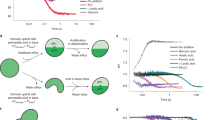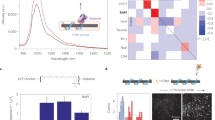Abstract
Introduction
The design of sensors that can detect biological ions in situ remains challenging. While many fluorescent indicators exist that can provide a fast, easy readout, they are often nonspecific, particularly to ions with similar charge states. To address this issue, we developed a vesicle-based sensor that harnesses membrane channels to gate access of potassium (K+) ions to an encapsulated fluorescent indicator.
Methods
We assembled phospholipid vesicles that incorporated valinomycin, a K+ specific membrane transporter, and that encapsulated benzofuran isophthalate (PBFI), a K+ sensitive dye that nonspecifically fluoresces in the presence of other ions, like sodium (Na+). The specificity, kinetics, and reversibility of encapsulated PBFI fluorescence was determined in a plate reader and fluorimeter. The sensors were then added to E. coli bacterial cultures to evaluate K+ levels in media as a function of cell density.
Results
Vesicle sensors significantly improved specificity of K+ detection in the presence of a competing monovalent ion, sodium (Na+), and a divalent cation, calcium (Ca2+), relative to controls where the dye was free in solution. The sensor was able to report both increases and decreases in K+ concentration. Finally, we observed our vesicle sensors could detect changes in K+ concentration in bacterial cultures.
Conclusion
Our data present a new platform for extracellular ion detection that harnesses ion-specific membrane transporters to improve the specificity of ion detection. By changing the membrane transporter and encapsulated sensor, our approach should be broadly useful for designing biological sensors that detect an array of biological analytes in traditionally hard-to-monitor environments.





Similar content being viewed by others
References
Bazzigaluppi, P., S. Dufour, and P. L. Carlen. Wide field fluorescent imaging of extracellular spatiotemporal potassium dynamics in vivo. Neuroimage, 104:110–116, 2015.
Bischof, H., et al. Novel genetically encoded fluorescent probes enable real-time detection of potassium in vitro and in vivo. Nat. Commun. 8:1–12, 2017.
Boyd, M. A., and N. P. Kamat. Designing artificial cells towards a new generation of biosensors. Trends Biotechnol. In Press, 2020.
Boyd, M. A., and N. P. Kamat. Visualizing tension and growth in model membranes using optical dyes. Biophys. J., 115:1307–1315, 2018.
Cayley, S., and M. T. Record. Roles of cytoplasmic osmolytes, water, and crowding in the response of escherichia coli to osmotic stress: biophysical basis of osmoprotection by glycine betaine. Biochemistry 42:12596–12609, 2003.
Cheng, C. J., E. Kuo, and C. L. Huang. Extracellular potassium homeostasis: insights from hypokalemic periodic paralysis. Semin. Nephrol. 33:237–247, 2013.
Dinnbier, U., E. Limpinsel, R. Schmid, and E. P. Bakker. Transient accumulation of potassium glutamate and its replacement by trehalose during adaptation of growing cells of Escherichia coli K-12 to elevated sodium chloride concentrations. Arch. Microbiol. 150:348–357, 1988.
Dufour, S., P. Dufour, O. Chever, R. Vallée, and F. Amzica. In vivo simultaneous intra- and extracellular potassium recordings using a micro-optrode. J. Neurosci. Methods 194:206–217, 2011.
Eil, R., et al. Ionic immune suppression within the tumour microenvironment limits T cell effector function. Nature 537:539–543, 2016.
Filosa, J. A., et al. Local potassium signaling couples neuronal activity to vasodilation in the brain. Nat. Neurosci. 9:1397–1403, 2006.
Halperin, M. L., and K. S. Kamel. Potassium. Lancet 352:135–140, 1998.
He, H., M. A. Mortellaro, M. J. P. Leiner, R. J. Fraatz, and J. K. Tusa. A fluorescent sensor with high selectivity and sensitivity for potassium in water. J. Am. Chem. Soc. 125:1468–1469, 2003.
Kasner, S. E., and M. B. Ganz. Regulation of intracellular potassium in mesangial cells: A fluorescence analysis using the dye, PBFI. Am. J. Physiol. Ren. Fluid Electrolyte Physiol. 262:F462–F467, 1992.
Kozoriz, M. G., J. Church, M. A. Ozog, C. C. Naus, and C. Krebs. Temporary sequestration of potassium by mitochondria in astrocytes. J. Biol. Chem. 285:31107–31119, 2010.
Kubitschek, H. E., M. L. Freedman, and S. Silver. Potassium uptake in synchronous and synchronized cultures of Escherichia coli. Biophys. J. 11:787–797, 1971.
Li, C., G. L. Law, and W. T. Wong. Luminescent Tb3+ complex with pendant crown ether showing dual-component recognition of H+ and K+ at multiple pH windows. Org. Lett. 6:4841–4844, 2004.
Liu, J., et al. A highly sensitive and selective nanosensor for near-infrared potassium imaging. Sci. Adv. 6:1–11, 2020.
Liu, J., et al. A sensitive and specific nanosensor for monitoring extracellular potassium levels in the brain. Nat. Nanotechnol. 15:321–330, 2020.
Lomora, M., F. Itel, I. A. Dinu, and C. G. Palivan. Selective ion-permeable membranes by insertion of biopores into polymersomes. Phys. Chem. Chem. Phys. 17:15538–15546, 2015.
McLaggan, D., J. Naprstek, E. T. Buurman, and W. Epstein. Interdependence of K+ and glutamate accumulation during osmotic adaptation of Escherichia coli. J. Biol. Chem. 269:1911–1917, 1994.
Meury, J., A. Robin, and P. Monnier-Champiex. Turgor-controlled K+ fluxes and their pathways in Escherichia coli. Eur. J. Biochem 151:613–619, 1985.
Meuwis, K., N. Boens, F. C. De Schryver, J. Gallay, and M. Vincent. Photophysics of the fluorescent K+ indicator PBFI. Biophys. J. 68:2469–2473, 1995.
Minta, A., and R. Y. Tsien. Fluorescent indicators for cytosolic sodium. J. Biol. Chem. 264:19449–19457, 1989.
Monnard, P. A., and D. W. Deamer. Membrane self-assembly processes: steps toward the first cellular life. Anat. Rec. 268:196–207, 2002.
Mueller, P., and D. O. Rudin. Development of K+Na+ discrimination in experimental bimolecular lipid membranes by macrocyclic antibiotics. Biochem. Biophys. Res. Commun. 26:398–404, 1967.
Newsom-Davis, J., et al. Autoimmune disorders of neuronal potassium channels. Ann. N. Y. Acad. Sci. 998:202–210, 2003.
Padmawar, P., X. Yao, O. Bloch, G. T. Manley, and A. S. Verkman. K+ waves in brain cortex visualized using a long-wavelength K+-sensing fluorescent indicator. Nat. Methods 2:825–827, 2005.
Palmer, B. F. Regulation Of Potassium Homeostasis. Clin. J. Am. Soc. Nephrol. 10:1050–1060, 2014.
Prindle, A., J. Liu, M. Asally, S. Ly, J. Garcia-Ojalvo, and G. M. Süel. Ion channels enable electrical communication in bacterial communities. Nature 527:59–63, 2015.
Rana, P. S., et al. Calibration and characterization of intracellular Asante Potassium Green probes, APG-2 and APG-4. Anal. Biochem. 567:8–13, 2019.
Rimmele, T. S., and J. Y. Chatton. A novel optical intracellular imaging approach for potassium dynamics in astrocytes. PLoS ONE 9:e109243, 2014.
Sica, D. A., A. D. Struthers, W. C. Cushman, M. Wood, J. S. Banas, and M. Epstein. Importance of potassium in cardiovascular disease. J. Clin. Hypertens. 4:198–206, 2002.
Steller, L., M. Kreir, and R. Salzer. Natural and artificial ion channels for biosensing platforms. Anal. Bioanal. Chem. 402:209–230, 2012.
Su, Z. F., X. Q. Ran, J. J. Leitch, A. L. Schwan, R. Faragher, and J. Lipkowski. How valinomycin ionophores enter and transport K+ across model lipid bilayer membranes. Langmuir 35:16935–16943, 2019.
Szatmári, D., et al. Intracellular ion concentrations and cation-dependent remodelling of bacterial MreB assemblies. Sci. Rep. 10:12002, 2020.
van de Velde, L., E. d’Angremont, and W. Olthuis. Solid contact potassium selective electrodes for biomedical applications—a review. Talanta 160:56–65, 2016.
Yellen, G. The voltage-gated potassium channels and their relatives. Nature. 419:35–42, 2002.
Zhou, X., F. Su, Y. Tian, C. Youngbull, R. H. Johnson, and D. R. Meldrum. A new highly selective fluorescent K+ sensor. J. Am. Chem. Soc. 133:18530–18533, 2011.
Acknowledgments
This work was supported by the Cornew Innovation Award from the Chemistry of Life Processes Institute at Northwestern University (to NPK) and the National Science Foundation (CBET-1844219 and CBET-1844336 to NPK). MAB was supported by the National Defense Science and Engineering Graduate Fellowship through the Department of Defense. AMD and NRC were assisted by a grant from the Undergraduate Research Grant Program, which is administered by Northwestern University’ s Office of Undergraduate Research, and by a grant from Northwestern’s Biomedical Engineering Department.
Conflict of interest
Margrethe Boyd, Anna Davis, Nora Chambers, Peter Tran, Arthur Prindle, and Neha P. Kamat declare that they have no conflicts of interest.
Ethical Approval
No animal or human studies were performed in this work.
Author information
Authors and Affiliations
Corresponding author
Additional information
Associate Editor Michael R. King oversaw the review of this article.
Publisher's Note
Springer Nature remains neutral with regard to jurisdictional claims in published maps and institutional affiliations.
Supplementary Information
Below is the link to the electronic supplementary material.
Rights and permissions
About this article
Cite this article
Boyd, M.A., Davis, A.M., Chambers, N.R. et al. Vesicle-Based Sensors for Extracellular Potassium Detection. Cel. Mol. Bioeng. 14, 459–469 (2021). https://doi.org/10.1007/s12195-021-00688-7
Received:
Accepted:
Published:
Issue Date:
DOI: https://doi.org/10.1007/s12195-021-00688-7




